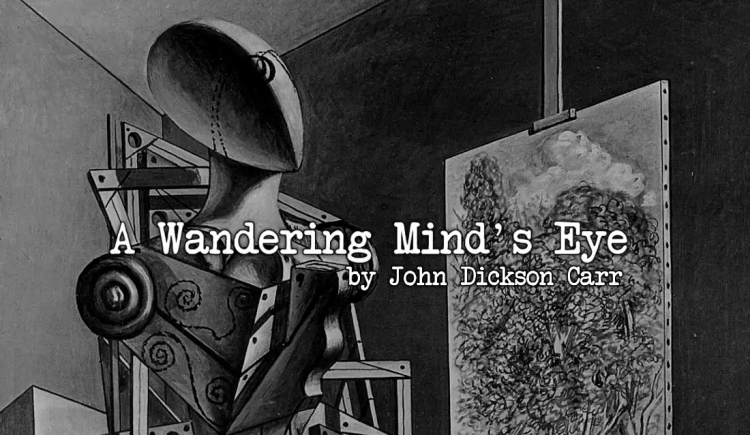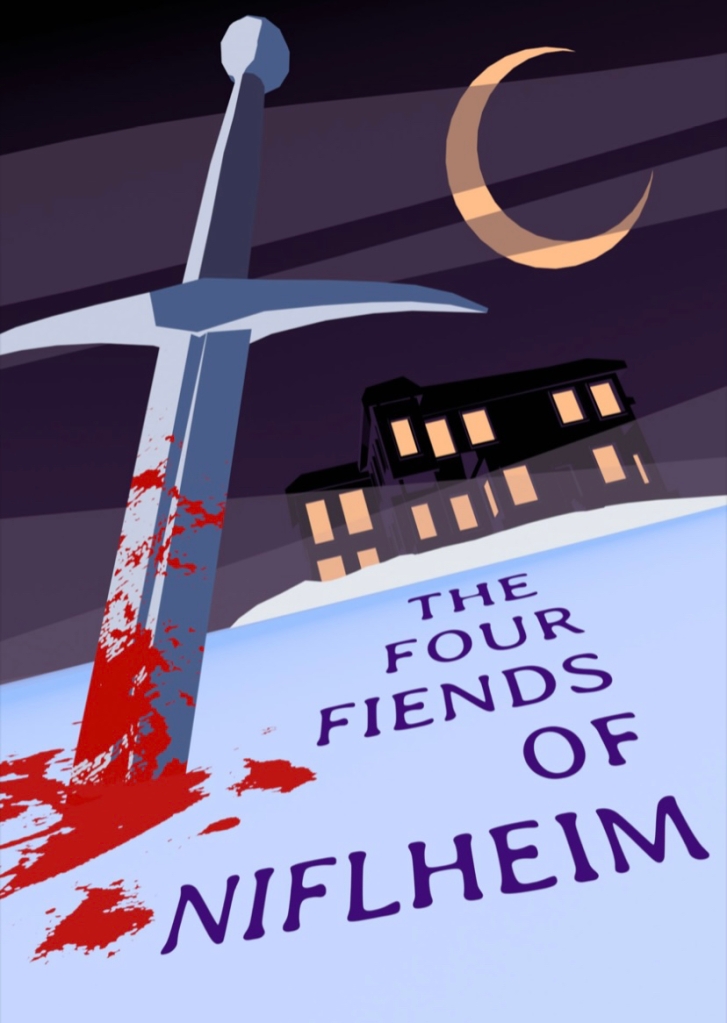One of the most influential authors to my writing, at least in recent years, is an author whose name I don’t know. You won’t find him at your local Barnes and Noble or on Goodreads, and all of his work is available for free. Though he has called himself a mere amateur in the past, yet the longest complete work of fiction I’ve written draws its conception directly to one of his books.
DWaM (sometimes referred to as DudeWithAMask) is a writer of murder mysteries and interactive fiction. He’s mainly known in some circles for writing edgy Ace Attorney fangames, though now writes more often in the Umineko universe. However, most of my exposure to his work has been the original content he’s put out over the last few years. His work tends to range from short stories to novellas, so they lend themselves well to quick reading throughout the day on a mobile device.
Having played a few of his old fangames, I can say his style has matured over the years into something truly unique. While DWaM’s older works could be grimdark to nearly comic degrees, this tone has developed into an aura of mystery that surrounds every scene, as if you’re reading a journal in an old, abandoned attic. However, other scenes draw from perfectly curated madness that leaves you simultaneously confused and amazed. DWaM has also mastered the sarcastic narrator, at once a willing participant and critic of their own life, without losing sight of his stories’ serious moments.
But of course, the primary reason I was drawn to DWaM’s stories was the impossible crime elements. Before I picked up John Dickson Carr or Gaston Leroux, I had to be introduced to the impossible crime genre with a modern, fresh take—and DWaM does just that. DWaM’s solutions can be brilliant and outrageous, but they are always cleverly foreshadowed, and unlike some classic crime novels they are matched with rich character work. You can blame DWaM for setting me down my current path, not just writing impossible crime mysteries but telling everyone who will listen how much I love them.
But still, no one I talk to ever has any idea who DWaM is. I wanted to change that, or at least have an overview of his best work ready that I could direct people to. So in this post, I’ll be outlining my top 5 works by DWaM, in order.
Some stipulations for this list: I haven’t included any fan projects, since I want it to be only original work. And also because I haven’t played most of them. DWaM likes to create cool Umineko fan projects that I can’t play because I haven’t finished Umineko, likely for the purpose of feeding off of my tears. I’m also sticking to prose, rather than interactive fiction of any kind.
And, a few honorable mentions. Aleph Null is an excellent novella that only doesn’t make the list because it’s not an impossible crime. However, it has some really interesting plot features and some very creative chapters from a stylistic perspective. Murder in the House of Want is a fun impossible crime story that puts an interesting twist on a trope often seen in the mystery genre (namely that of a mystery writer committing the “perfect murder”). A Ship For Too Many Bottles is an ingenious story set in a fantastical world that I honestly wish we could see more of, but it’s well worth the read on its own.
With that out of the way, let’s get into the bulk of the list. Click the links in the headings to be taken straight to each story!
Yeah, I know what you’re thinking. If this author’s so great, why is one of your favorite works by them a review of some random mystery novel? Isn’t that super insulting to everything else they’ve written?
First of all, reviews are a totally legitimate art form, and if someone argued that this review was better than half my short stories I would hate them but I would at least understand. But more importantly, a skilled writer can tell a story through anything, like checkbooks or post-it notes—and yes, a review of some random mystery novel.

“‘A Wandering Mind’s Eye’ by John Dickson Carr” by DWaM discusses DWaM’s discovery of an overlooked short story by the impossible crime legend which has an unusual twist. In trying to explain this odd story to the reader, he touches upon ideas of truth and fabrication (or how we define an original work) in a unique and compelling way. As the story progresses, you discover this story is more similar to DWaM’s other works than you might think.
There’s not much else I can say. You’ve probably picked up that this is more than a simple book review, so I want to spoil as little as possible. The review is incredibly densely-layered for what it is, and I didn’t realize the depth of its brilliance until well after I’d finished it.
Another thing that sets it apart though is how personal it is. With DWaM himself as the narrator, it’s the most directly personal his work ever gets, and it comes across in the subjects breached. He even takes time to comment on his worries as a writer. It’s one of many cases of DWaM pushing the limits of how stories can be told.
If you want a good, short introduction to DWaM’s work, this is an excellent option. You’ll find most of my favorite things about his work here.

The Four Fiends of Niflheim is DWaM’s spin on your typical closed-circle mystery. Several people gather in a mansion which becomes closed off from the world and are slowly killed off one by one. But the mansion is built on a frozen Scandinavian lake, the characters are eccentric yet grounded, and each murder is equally complex and impossible. This novella revitalizes what I feel has become a clichéd mystery set-up.
The main stand-out here is the characters. You’d be hard-pressed to get me to name a single character in a typical ensemble mystery, but I could name every character in this book—and I’ve only read it once! DWaM skillfully uses striking physical characteristics to set the characters apart and then backs those up with intricate backstories and vibrant personalities that clash with each other to create exciting conflicts. Switching the narrative focus between each character helps develop them separately and gives us a reason to care about their possible deaths.
The mysteries, of course, are clever, but the first murder repeatedly comes to mind as one of the most brilliant solutions I’ve seen. The motivations behind the killings are just as satisfying to unravel, even tying in nicely with the actual mechanics of the crimes. DWaM uses incredible misdirection to hide the killer’s identity from the reader and the characters until you finally reach the solution and follow on through every intricately-placed detail of the truth.
However, compared to DWaM’s other stories, The Four Fiends of Niflheim is dark and gruesome in a way that can border on disturbing. The violence is handled well and never glorified, but it still makes it hard to recommend as a result. Additionally, there’s a certain plot development that I felt didn’t add much aside from making the story more tragic than it needed to be. Still, the story’s characters and mysteries easily outshine these minor issues.
With all that said, only one question remains. Who are the four fiends of Niflheim? I don’t know. I never figured that out.

A Eulogy for Reason is like no other book I’ve read. I would perhaps place it in the pre-apocalyptic genre. The reader is intensely aware that something unsettling is burrowing beneath the surface of the novel, but understanding what that could be is difficult. This is a likely intentional effect of the writing style.
Each chapter is written from the perspective of a different individual at an unknown time on the same day. The only thing we have to ground us before each chapter is the character’s name and an appropriate pseudonym for them. Simply finding out what’s happening in the story is a challenging puzzle in and of itself. Each time I spotted a connection between two characters or realized I was reading the voice of a person I’d seen before, I felt a jolt of epiphany. For some people, this style of reading might be too confusing to get through, but I thought it was fun. I do think it might have been more difficult without being able to search for names in the text using my phone.
DWaM also uses this style to tell some chapters in unique ways, such as writing one in reverse chronological order or interspersing another with snippets from an IRC chat. Either way, there’s a tinge of melancholy at the end of each chapter, as we realize that we’ll never hear from its narrator again—at least not as deeply as we did before. This effect is one of the many contributors to the book’s overall tone of hopelessness.
The mystery itself is fairly simple. An old woman is burned to death in her room, whose window and door have been locked and sealed from the inside. The solution is a little weak, but it’s not the main focus of the narrative. The killer is even identified early in the book, but we don’t know much about them until the end. Discovering how each character relates to the others in an intricate web of deceit is the story’s primary mystery, and that one is much more satisfying.
Unlike some of the others on this list, I suspect A Eulogy for Reason might be polarizing, with most either loving or hating it. However, I think it’s an interesting experiment and well worth multiple readings to fully appreciate.

My pick for the top 2 spot is actually fairly short compared to the others—called a “short story” despite having multiple chapters—but I think it’s still comparable to DWaM’s novellas. Tower of Babel is one of the strongest impossible crime stories I’ve ever read, with an ingenious solution, a fantastic narrative, and interesting characters.
The entire story hinges on a massive building referred to as the Tower of Babel where an abusive magician once raised his adopted children. One of my favorite things to see in a mystery is weird architecture, and this tower is such a strong example that it defines the story as a whole, becoming more than just a setting.
The basic gist of the story is that Graham Richter, the magician, gives his children a chance to kill him, with the stipulation that his death will trap them in the tower. As you can probably guess, they do become trapped there, leading to a hopeless take on the detective story—as even solving the murder won’t save them. However, once the solution is revealed, we can appreciate its ingenuity, though my favorite part is that it hinges on a hidden detail that makes the story’s background even more disturbing.
The characters in this story aren’t as memorable as in others, as expected because of its short length. The clearest stand-out is Graham Richter, who acts as an antagonist beyond the scope of the killer. His unsettling presence dominates every inch of the story, from the setting to the characters’ motivations, and will likely loom over the reader’s head well after the conclusion. If you’re looking for a short and easy mystery to read, definitely pick this one up.

Hear the Devil Sing is emblematic of all of DWaM’s strengths as a writer. I’d argue it’s one of the best books I’ve ever read. The plot balances mind-twisting insanity with sweet sentimentality, every step of the mystery is brilliantly constructed, and the main character Jake is one of my favorite human beings.
The premise is simple: a man is murdered in a closed bedroom during a party while all suspects are accounted for. He then meets with the devil and is granted a second chance at life provided he can solve his murder. The catch is that he’s launched 30 years in the future, when most have forgotten the crime.
The plot takes a little while to get going, but that works in its favor. Compared to The Four Fiends of Niflheim, the characters don’t stand out immediately, but that makes them more realistic. Hear the Devil Sing is a lot more emotional and relational than mysteries I’m used to. Jake’s perspective grounds the narrative even during it’s wilder moments. In fact, the story opens with a bad LSD trip, but in a world with devils this doesn’t feel out of place.
The mystery seems simple at first, but this hides great complexity. It’s impressive how many twists are packed in such a short story. Obviously, I can’t speak much on that, but it’s nothing short of brilliant. The plot and mystery are so well intertwined that some important clues don’t even stand out as relevant until they become vital to understanding the narrative. Even just two or three chapters can be enough to completely change your understanding of what’s going on in the story.
I think what stands out most about Hear the Devil Sing is that it’s not really a mystery—genre-wise, that is. Obviously the detective elements are a large part of it, but I’d sooner call it a romance. Jake’s recovery from a lost love and desire to open himself up again is what primarily drives the plot; this is simply reflected through the lens of solving a murder. As a result, the novella has a feel-good ending, and I became much more invested in the characters than usual. But, of course, the closed room murder is great too.
I don’t really have any complaints about Hear the Devil Sing. It’s pretty good. They should make it a movie or something. Now go read it, or I’ll cry.
Anyway, that’s all. You’ll see me again when DWaM finally releases Vampire Castle (context: this won’t happen). Peace!
A Virtue of Machine Souls deserves better, but it’s a solid list, and one that I definitely agree with.
Incidentally, I’m pretty sure that the four fiends in Niflheim were (rot13) Fgrsna’f sbhe sevraqf, avyfybggnyhqqrnaquhtb.
LikeLike
Yeah that one’s solid too, probably was worth a mention. Though while the solution’s really good, I don’t remember a whole lot of other details about it, which is why I didn’t put it as high.
That would make sense. I think I considered something like that in the past but am just terrible at counting
LikeLike